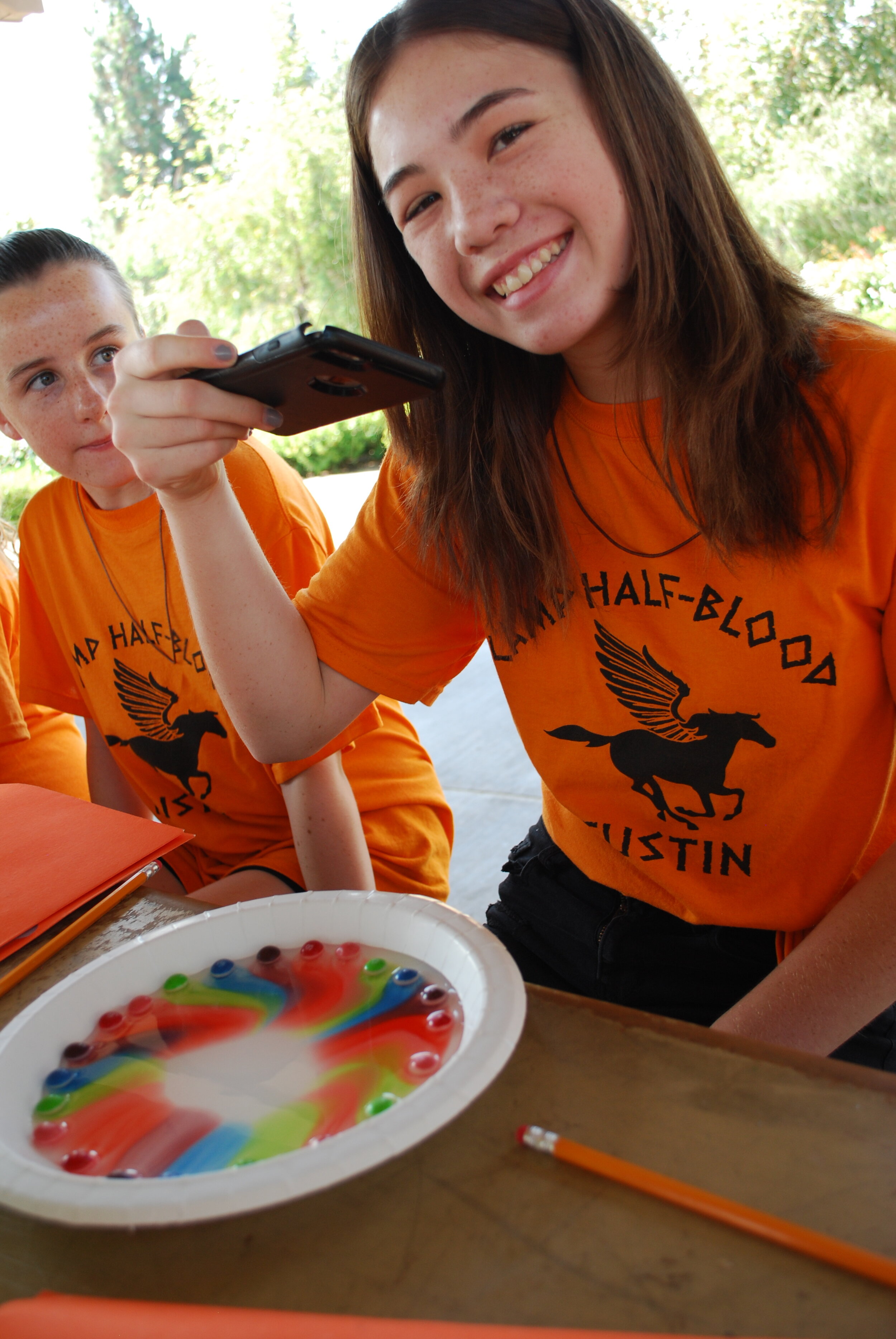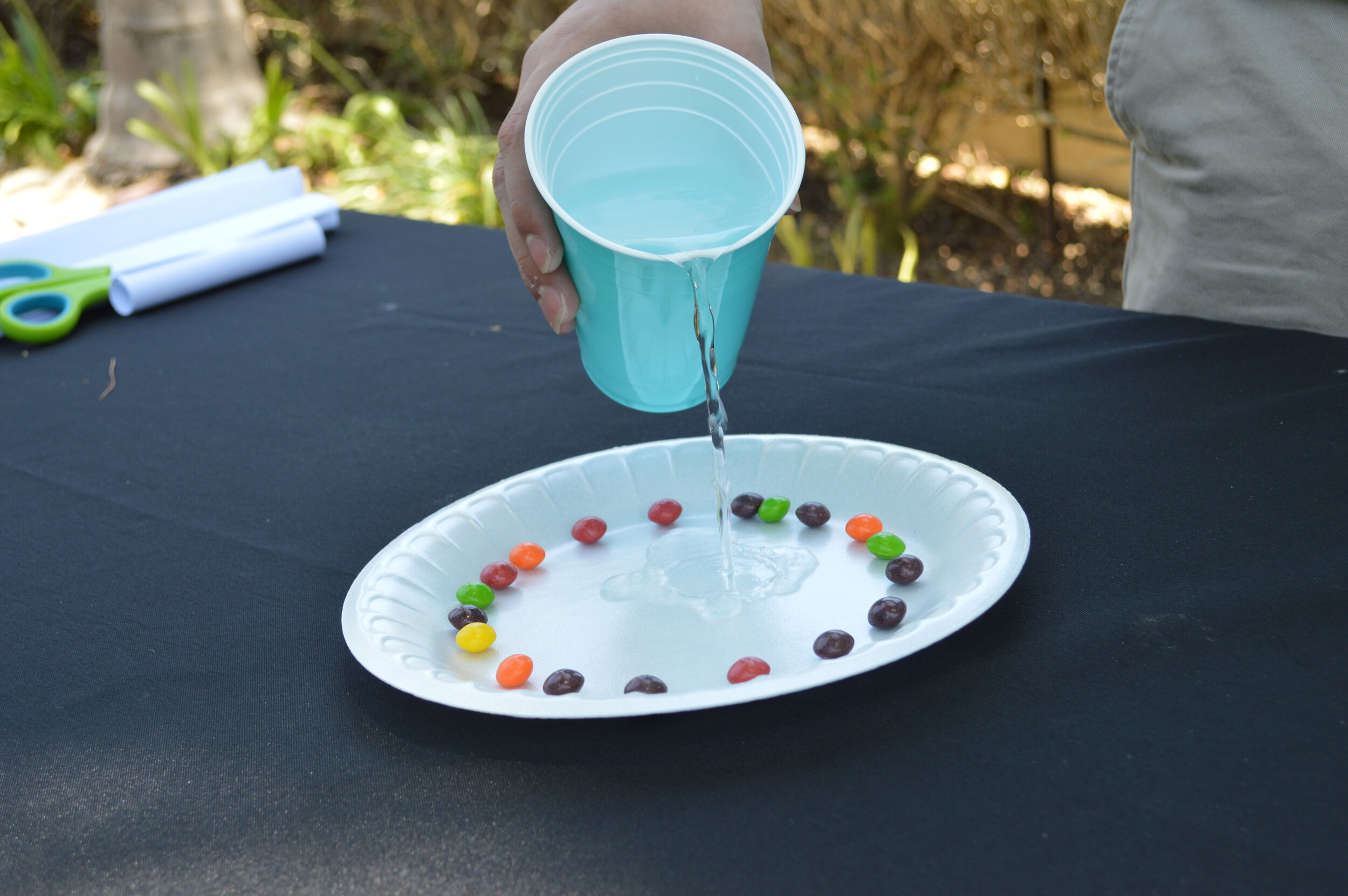Skittle Science
Looking for a quick and easy boredom buster? Look no further! Explore diffusion and solubility in a very *aesthetic* way using only colorful candy and water.
Procedure
Step 1
Arrange the candy in a circle around the plate.
Step 2
Slowly pour water into the center of the plate until the water is touching all candy pieces. Be sure not to pour too much water, or the candy may start to shift.
Step 3
Watch the beautiful diffusion unfold before your eyes.
Science Explanation
Kindergarden - 2nd Grade . . .
- Matter is the "stuff" that makes up everything. Tables, plants, phones, animals, water, you; are all matter. Even though we can’t always see it, like in the air we breathe, it is always there.
- Matter of any type can be divided into particles that are too small to see. These particles interact in many different ways with the particles around them.
- One type of interaction is diffusion. In nature, particles usually move from an area of high concentration (where there are a lot of that particle close together) to an area of lower concentration (where there are less of the particles less close to each other).
- Think of it like a crowded room. If there are a lot of people crowded in your classroom, but then your teacher opens the door to the hallway or playground, people tend to spread out so everyone has more space. This is essentially diffusion of people!
- In this case, the dye particles are very crowded (high concentration) in the candy shell. When the water first touches the candy, there are no dye particles in the water. Interactions between the candy dye and water allow the dye particles to move through the water. They move from an area of high concentration (on the candy) an area of lower concentration (the water).
- We can observe diffusion and the particles interacting as color moving from the candy to the center of the plate. This creates some pretty cool patterns.
3rd - 5th Grade . . .
- Matter is the “stuff” that makes up everything. Tables, plants, phones, animals, water, you; are all matter. Even though we can’t always see it, like in the air we breathe, it is always there.
- Matter of any type can be divided into particles that are too small to see. These particles interact in many different ways with the particles around them.
- One type of interaction is diffusion. In nature, a type of particle typically moves from an area of high concentration (where there are alot of that particle close together) to an area of lower concentration (where there are less of the particles less close to each other). This process helps nature achieve balance, or equilibrium.
- Think of it like a crowded room. If there are a lot of people crowded in your classroom, but then your teacher opens the door to the hallway or playground, people tend to spread out so everyone has more space.
- In this case, the dye particles are highly concentrated in the candy shell. When the water first touches the candy, there are no dye particles in the water. Interactions between the candy dye and water allow the dye particles to move through the water. They move from an area of high concentration (on the candy) an area of lower concentration (the water).
- We can observe diffusion and the particles interacting as color moving from the candy to the center of the plate. This creates some pretty cool patterns.
- If we let the candy dye continue to diffuse, eventually the colors will mix. Each dye is a different particle, so they keep mixing until we only see a brown-black color. This is equilibrium!
NGSS 5-PS1-1
Math Extensions (K-4)
Kindergarden . . .
- Sort the different candies into groups based on their colors. How many of each color are in each group? Which color group has the most candies? Which color group has the least number of candies? CCSS.MATH.K.MD.B.3 , CCSS.MATH.K.CC
- After you arrange the candies on the plate, count how many of each color you used. Now, predict how many of each color you have left. Count to check your work. CCSS.MATH.K.OA
- Try arranging the candies in different shapes. For example, a rectangle, square, or triangle. How many sides and corners do each of these shapes have? CCSS.MATH.K.G
1st Grade . . .
- Sort the different candies into groups based on their color. Count how many candies are in each group. Make a table to record your data.
- After you arrange the candies on the plate, count how many of each color you used. Record this in your data table. Can you write an equation to represent how many candies of each color you have left? Solve these equations and count to check your work. CCSS.MATH.1.OA.D
- Try arranging the candies in different shapes and sizes. For example, a rectangle, square, trapezoid, triangle or even half-circle or quarter-circle. How many sides and corners do each of these shapes have? CCSS.MATH.1.G
2nd Grade . . .
- Sort the different candies into groups based on their color. Determine if each color group has an odd or even number of candies in it. Remember, a number is even if you can pair the objects with no leftovers or count them by 2s with no leftovers. CCSS.MATH.2.OA.C.3
- Draw a bar graph to represent the number of candies in each color category. Which color has the most candies? CCSS.MATH.2.MD.D.10
- Try arranging the candies in different shapes and sizes. For example, a triangle, pentagon, hexagon, or different types of quadrilaterals (square, rectangle, trapezoid). How many sides and angles do each of these shapes have? CCSS.MATH.2.G.A.1
3rd Grade . . .
- Sort the different candies into groups based on their color. Count how many candies are in each group and record this in a bar graph. Which color has the most candies? How much greater is this color category than the other categories? Which color has the least candies? How many less is this category than the other categories? CCSS.MATH.3.MD.B.3
- Express the number of candies in each group as a fraction of the total number of candies.
- For example, if I have 5 red candies and 25 total candies, the fraction of red candies I have is 525
- Compare the fractions of each color group. They have the same denominator but different numerators. Which color makes up the greatest fraction? Which color makes up the smallest fraction? Use the symbols >, =, or < to compare. CCSS.MATH.3.NF.A.3.D
4th Grade . . .
- Sort the different candies into groups based on their color. Count how many candies are in each group. Express the number of candies in each group as a fraction of the total number of candies.
- For example, if I have 5 red candies and 25 total candies, the fraction of red candies I have is 525
- Find the sum of the fractions of each color category to verify that all your fractions add together to make a whole. CCSS.MATH.4.NF.B.3
- Try arranging the candies in different shapes. For example, a right triangle, isosceles triangle, equilateral triangle, or different types of quadrilaterals (square, rectangle, trapezoid). Do these shapes have any parallel or perpendicular lines? CCSS.MATH.4.G.A.2
Written by Julia Wang




